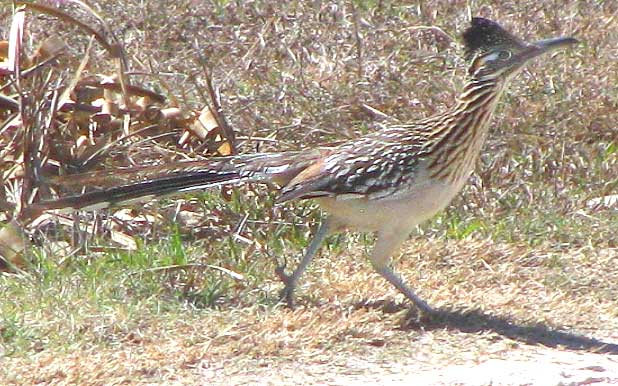Excerpts from Jim Conrad's
Naturalist Newsletter

from the March 10, 2013 Newsletter issued from the valley of the Dry Frio River in northern Uvalde County, southwestern Texas, on the southern border of the Edwards Plateau; elevation ~1750m (~5750 ft); N29.62°, W99.86°; USA
ROADRUNNER
White-tailed and Axis Deer, Desert Cottontails, Eurasian Collard Doves and other critters roam the little gravel road in front of the cabin as if humans here weren't much of a bother, and usually we're not. If someone in a pickup-truck rattles down the road, wildlife just steps into the tall grass and junipers and let the vehicle pass, then return to the sun and wind to continue their perambulations. You can see one such traveler running briskly down the road at the top of this page.
That's the Greater Roadrunner, GEOCOCCYX CALIFORIANUS, the "Greater" in the name meant to distinguish it from the slightly smaller Lesser Roadrunner we've met in Mexico.
Field guides show that the Greater Roadrunner is distinguishable from the Lesser by its more heavily striped throat and chest, and bigger bill. However, the throat and chest of the bird in the above picture don't look much different than the throats and chests of Mexico's Lesser Roadrunners, and neither do I notice much difference in the bills. You can see what you think by comparing the above picture with one we took in the Yucatan at http://www.backyardnature.net/n/10/101205rr.jpg.
The Latin genus name, Geococcyx, means ground-cuckoo, and it's true that roadrunners are members of the Cuckoo Family -- big ones reaching about two feet long (60cm) -- and that they spend most of their time on the ground. If you think about it, though, it's true that our roadrunner has a long tail with outer feathers boldly tipped with white, just like North America's Yellow-billed and Black-billed Cuckoos, plus it has a strong, down-curved beak like other cuckoos. An even more profound anatomical difference is that unlike the vast majority of other birds roadrunner feet bear two toes facing forward and two backwards -- their feet are "zygodactyl." A shot showing our Greater Roadrunner from the back displaying one of his zygodactyl feet is shown below:

Roadrunners prey on lizards, rodents, insects and even small birds. Their diet includes venomous spiders, scorpions and rattlesnakes. They've been seen working in pairs to overcome large snakes.